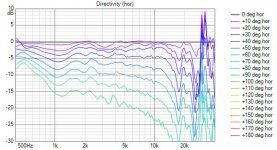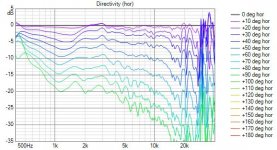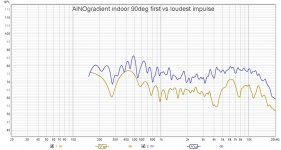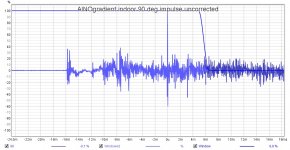I did a bit of a search but I am terrible at searching so please forgive.
When measuring a horn/waveguide for directivity, at what point is it best to rotate the speaker? Mouth? Horn entrance? Voice coil? Something else?
And is the rotation location an agreed upon thing?
TIA
When measuring a horn/waveguide for directivity, at what point is it best to rotate the speaker? Mouth? Horn entrance? Voice coil? Something else?
And is the rotation location an agreed upon thing?
TIA
Hi Kevmoso
Rotate around acoustic center.
Takes good measurements, can shift with frequency (but way less than folklore sometimes suggests, ime),
and can leave you scratching your head.
I believe i have found acoustic center, when the measured fixed delay (time of flight plus processor latency) is constant throughout rotation.
Rotate around acoustic center.
Takes good measurements, can shift with frequency (but way less than folklore sometimes suggests, ime),
and can leave you scratching your head.
I believe i have found acoustic center, when the measured fixed delay (time of flight plus processor latency) is constant throughout rotation.
But when the horn/wg is set on the baffle of a multiway speaker, one must make a compromise to set rotation axis - typically the front plane of the baffle.
https://www.artalabs.hr/download/arta-user-manual.pdf
VituixCAD help 2.0
https://www.artalabs.hr/download/arta-user-manual.pdf
VituixCAD help 2.0
I would instead rotate around the geometric source location, the physical centre, as it represents the apex of the wavefront. While this can vary, by default it would be around the horn throat.Rotate around acoustic center
We may be splitting hairs because if you take enough measurements, you get all the information anyway.
Pls let me clarify why i think it's best to rotate around acoustic center.
First, if the horn and waveguide's frequency response is all that's being looked at, for determining directivity, then it probably doesn't matter much. I most often eyeball a geometric center then, like Allen suggests.
If i am working with matching the horn and waveguide to other multiway drivers, I think acoustic center is the way to go. So Juhazi, what i do then is try to get the acoustic center directly over the center of the turntable. When the measured delay doesn't change with rotation, I know I've found center.
And then i can see what's going on with phase as well as mag.
I use the CD's acoustic center, as opposed to the mid driver's, because phase variations from drivers that are not rotated on acoustic centers, are greater the higher the frequency.
I've found i simply need to see how both mag and phase move under rotation for improved xover work. Polars getter better and easier to adjust, the closer I can get to rotation over centers.
So anyway, that's why i recommend acoustic centers...it's a 'best practices' type thing, that let's me use measurements for more than just looking at directivity. Sorry if i was overcomplicating.
First, if the horn and waveguide's frequency response is all that's being looked at, for determining directivity, then it probably doesn't matter much. I most often eyeball a geometric center then, like Allen suggests.
If i am working with matching the horn and waveguide to other multiway drivers, I think acoustic center is the way to go. So Juhazi, what i do then is try to get the acoustic center directly over the center of the turntable. When the measured delay doesn't change with rotation, I know I've found center.
And then i can see what's going on with phase as well as mag.
I use the CD's acoustic center, as opposed to the mid driver's, because phase variations from drivers that are not rotated on acoustic centers, are greater the higher the frequency.
I've found i simply need to see how both mag and phase move under rotation for improved xover work. Polars getter better and easier to adjust, the closer I can get to rotation over centers.
So anyway, that's why i recommend acoustic centers...it's a 'best practices' type thing, that let's me use measurements for more than just looking at directivity. Sorry if i was overcomplicating.
Thanks for the great input.
The reason I asked happened as I was measuring polars for three different waveguides I have (SEOS15, b52 and a 3d printed ST260 as shared by mabat). On one of them I noticed that the 90degree pulse had shifted relative to the 0 and had indeed shifted everywhere in-between. I did not investigate all of them for this shift. No real concern while simply comparing the waveguides alone but come time to integrate with other drivers will be different.
This was all to compare these against the ST260 which is designed as a free standing guide and this is the one I am planning to use. See attached normalized polars for why I plan to use it.
So it seems that I will need to pinpoint where the elusive acoustic center is before trying to integrate with other drivers.
The reason I asked happened as I was measuring polars for three different waveguides I have (SEOS15, b52 and a 3d printed ST260 as shared by mabat). On one of them I noticed that the 90degree pulse had shifted relative to the 0 and had indeed shifted everywhere in-between. I did not investigate all of them for this shift. No real concern while simply comparing the waveguides alone but come time to integrate with other drivers will be different.
This was all to compare these against the ST260 which is designed as a free standing guide and this is the one I am planning to use. See attached normalized polars for why I plan to use it.
So it seems that I will need to pinpoint where the elusive acoustic center is before trying to integrate with other drivers.
Attachments
Thanks Mark for the excellent answer. Acoustic center is indeed the axis you want to pivot around when making measurements.
Some more tinkering...
And what happens when measurement angle exceeds the wall angle of the horn? The acoustic center must move then? At least spl obviously drops drastically.
I have noticed that at least REW (and perhaps ARTA) in one channel measurements picks up the highest impulse peak as 0 time. When direct sound has lower spl than some delayed reflection, you will see nice response, but it's the reflection! This happens when measuring dipoles with lateral nulling at 70-110deg, indoor measurements! I suppose this might happen with deep horns as well.
And what happens when measurement angle exceeds the wall angle of the horn? The acoustic center must move then? At least spl obviously drops drastically.
I have noticed that at least REW (and perhaps ARTA) in one channel measurements picks up the highest impulse peak as 0 time. When direct sound has lower spl than some delayed reflection, you will see nice response, but it's the reflection! This happens when measuring dipoles with lateral nulling at 70-110deg, indoor measurements! I suppose this might happen with deep horns as well.
Attachments
The file names show if you hover a cursor over the thumb but that doesn't happen with a touch device. My bad for not labeling them.
Yes the first is the lovely ST260. Second is the SEOS15 and third is B52.
JuHazi I noticed the same thing in single channel measurement in ARTA. I didn't realize wtf was happening until your explanation so thank you for that. Didn't happen in dual channel mode.
Yes the first is the lovely ST260. Second is the SEOS15 and third is B52.
JuHazi I noticed the same thing in single channel measurement in ARTA. I didn't realize wtf was happening until your explanation so thank you for that. Didn't happen in dual channel mode.
Some more tinkering...
And what happens when measurement angle exceeds the wall angle of the horn? The acoustic center must move then? At least spl obviously drops drastically.
I have noticed that at least REW (and perhaps ARTA) in one channel measurements picks up the highest impulse peak as 0 time. When direct sound has lower spl than some delayed reflection, you will see nice response, but it's the reflection! This happens when measuring dipoles with lateral nulling at 70-110deg, indoor measurements! I suppose this might happen with deep horns as well.
Yep, once past horn wall angle, delay increases.
Although I believe once past horn wall angle, there is no point bring those measurements in to the tuning process. IOW, they simply are what they are, once optimal tuning is made within the designated pattern.
Interesting about single channel, and direct vs reflected impulse peak.
Surprising really, didn't know that could happen.
I always use dual channel for tuning and xover development, and have never seen a reflection that could dominate direct.
(I use single channel solely for post-tuning distortion measurements, etc.)
I should add, i rarely do any polar work indoors...unless it's polar-bear cold outside 😀
The file names show if you hover a cursor over the thumb but that doesn't happen with a touch device. My bad for not labeling them.
Yes the first is the lovely ST260. Second is the SEOS15 and third is B52.
JuHazi I noticed the same thing in single channel measurement in ARTA. I didn't realize wtf was happening until your explanation so thank you for that. Didn't happen in dual channel mode.
The files names do show. 😱
I'm just a dumb **** that didn't know it works like that 😛
Mark, it looks as though you are describing about the same thing. Where I ran aground is that too many people use the term 'acoustic centre' already to mean something else.. the measured point of origin in an axial response measurement based on delay/distance. Obviously we can't apply that other definition to a compression driver who's path may be convoluted and who's wavefront apex does not coincide with it.
Yes. Also it's horn dependent and it changes with frequency too.Juhazi said:And what happens when measurement angle exceeds the wall angle of the horn? The acoustic center must move then? At least spl obviously drops drastically.
I should expand a little on Mark's great answer. If you are measuring an axisymmetric horn, you will have the same acoustic center for both the horizontal and vertical.
A rectangular horn that has quite different horizontal and vertical coverage patterns can have different acoustic centers for the vertical pattern versus the horizontal, in addition to pattern flip where the horn is starting to loose it's narrower coverage.
The different horizontal and vertical acoustic centers of a rectangular horn is akin to an astigmatism.
A rectangular horn that has quite different horizontal and vertical coverage patterns can have different acoustic centers for the vertical pattern versus the horizontal, in addition to pattern flip where the horn is starting to loose it's narrower coverage.
The different horizontal and vertical acoustic centers of a rectangular horn is akin to an astigmatism.
- Home
- Loudspeakers
- Multi-Way
- rotation axis measuring horn/waveguide directivity




